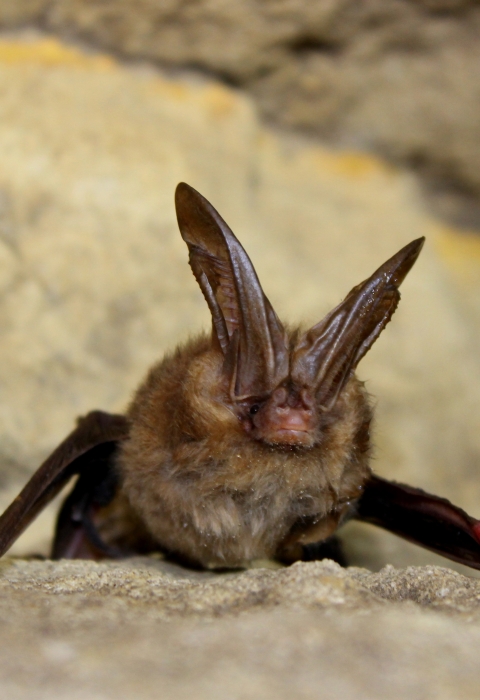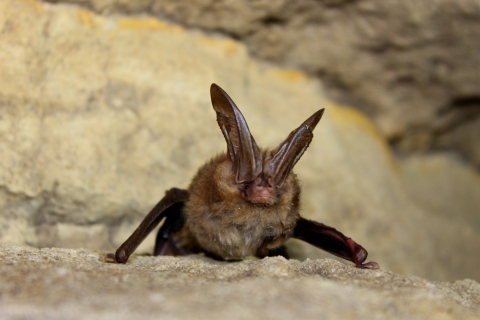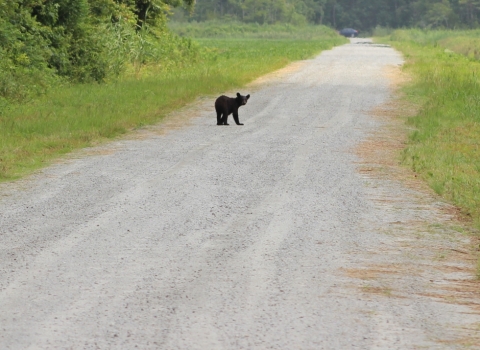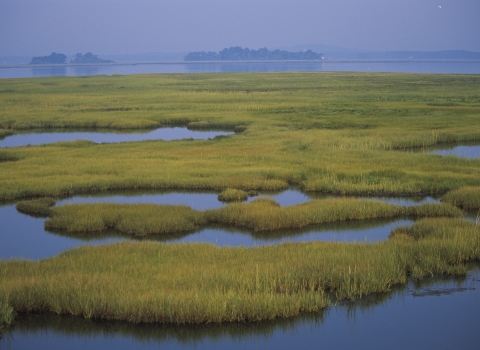The Virginia big-eared bat was placed on the federal endangered species list in 1979. Found mainly in Virginia, West Virginia, and Kentucky, there is one population in North Carolina. In the early 1980s, scientists discovered two hibernation sites for that North Carolina population, a pair of caves at Grandfather Mountain. That these sites were on protected land was good news for the bats – their winter home is protected in perpetuity. However, a mystery persisted.
“Virginia big-eared bats roost in caves year-round, so when they wake from hibernation, they migrate to their summer caves, with the females coming together in a maternity roost – the place where pups are born and reared,” said Sue Cameron, biologist with the U.S. Fish and Wildlife Service. “A foundation for conserving bats is protecting their hibernation sites and their maternity roosts.”
In early spring, the Grandfather Mountain bats leave their hibernation cave, but where were they going?
To the northwest, Grandfather Mountain is bordered by N.C. 105. Under Endangered Species Act protections, widening that road required evaluating the project for impacts to threatened or endangered species, and there were concerns about how the project might impact Grandfather Mountain’s Virginia big-eared bats, especially the undiscovered maternity roosts.
“For the bats, the worst-case-scenario was if the highway 105 work made any maternity roosts unusable,” said Cameron. “If we could find out more about those bats, we could use that information in planning the 105 widening and every other transportation project in the area.”
To learn more about the movement of Virginia big-eared bat from Grandfather Mountain, NCDOT enlisted the help of Indiana State University researcher Joy O’Keefe. Tracking those bats, and possibly discovering their maternity roosts, became the project of O’Keefe’s graduate student, Joey Weber.
“The Department of Transportation noted that while they knew where the bats hibernated, they had no idea where they went in summer. I knew that this would be a big telemetry project, in which we’d need to track bats from the cave to their summer roosts,” said O’Keefe.
To track the bats, Weber attached radio transmitters to bats just before they left their Grandfather Mountain hibernation site. The signals from those transmitters were picked up in two ways. The first was a network of portable towers set up around Grandfather Mountain and along N.C. 105. When a bat flew near one, the tower would record the signal from the bat’s transmitters. Additionally, Weber and his crew would drive the area around Grandfather Mountain, with an antenna and receiver in the car picking up the bat’s signals.
Working over two seasons, with help from the N.C. Wildlife Resources Commission, they were able to follow the bat’s signals to the main maternity roost – a spacious cave with stable, cool temperatures and little airflow located on private property. Scientists discovered not only where the bats gave birth and raised pups, but also several other caves used for summer roosting. They also collected data on where and when the bats were crossing N.C. 105 and other area roads – both as part of their migration and in foraging for food - which was important for the North Carolina Department of Transportation (NCDOT).
“This study revealed that Virginia big-eared bats use both primary and alternate roosts during the summer maternity season. We really haven’t documented this behavior in this species, though we do see it in other bats that roost in trees. It’s interesting to see that a cave bat like the Virginia big-eared bat will alternate between using a roost with 300+ of her closest pals for a few days and roosting alone in a rock shelter on other days. We also gained some detailed data on the nightly movements of these bats and I expect this will be valuable for identifying significant foraging patches and the corridors that connect them,” said O’Keefe.
NCDOT had the information they needed, but what if that information could take efforts to conserve the bat even further? Conserving the maternity roost sites would mean North Carolina’s population would be protected at the bat’s two most vulnerable time periods – hibernation and child-rearing - and would be a tremendous stride in ensuring the population’s long-term well-being. As Weber, O’Keefe, and the NCDOT completed their part in the bat’s story, a new chapter was set to begin, with the Blue Ridge Conservancy taking the lead.
“We met Joy and Joey at the maternity roost, and they got us involved,” said Eric Hiegl, the conservancy’s director of land protection and stewardship. “Ensuring the protection of the main maternity roost, as well as nearby roosts, would require protecting several properties. We contacted the individual landowners and everyone was interested in selling their land. That never happens.”
Across the spectrum of conservation non-profits, land conservancies are usually the ones taking the lead in ensuring important natural areas remain in a natural state. Often that means working to get it under state or federal ownership or management. One of the key parcels identified in Weber’s study was large, greater than 100 acres, and it was for sale. But land is expensive, and it takes time for a non-profit to raise money for a purchase, therefore a little help was needed.
A private supporter was able to step in, purchase the land and hold it, ensuring it wouldn’t be developed while the land conservancy raised money to purchase the property and put it into permanent conservation. The conservancy cobbled money together from a trio of sources – a North Carolina grant program which helps protect key conservation land; a grant program of the U.S. Fish and Wildlife Service which provides money for states to conserve endangered species habitat; and North Carolina State Parks. All those funding sources came together during the fall of 2017, and in December of that year, 174 acres was turned over to N.C. State Parks, to become a state natural area managed by Grandfather Mountain State Park. Unlike state parks, where recreation and visitor use can play a large role, state natural areas are designed to protect areas for scientific, aesthetic, or ecological value, with access focused on stewardship, not recreation. In this case, the land helps ensure North Carolina is doing its part to recover this endangered bat.





